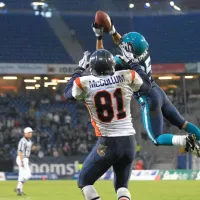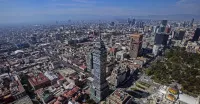Cruz Azul is a professional football club based in Mexico City, competing in Liga MX. Founded in 1927 in Jasso, Hidalgo, it officially moved to Mexico City in 1971. The club changed its name a couple of times, adopting its current name in 2022. Since 2025, Cruz Azul plays its home matches at the Estadio Olímpico Universitario. Its headquarters are in La Noria, Xochimilco, in southern Mexico City.
1923: Carlos Garcés López plays for Mexico
In 1923, Carlos Garcés López played for Mexico's national team in its first official matches.
1925: Initial Plans for a Baseball Team
In 1925, the cooperative initially planned to form a baseball team before Carlos Garcés López advocated for football.
March 1927: Football Selected as Official Sport
On March 22, 1927, the cooperative held a referendum and selected football as the company's official sport.
May 1927: Team Formally Established
On May 22, 1927, the Cruz Azul football team was formally established, with Carlos Garcés López as its first manager.
1927: Club Foundation
In 1927, Club Deportivo, Social y Cultural Cruz Azul A.C. was founded in Jasso, Hidalgo.
1928: Carlos Garcés López in Olympic squad
In 1928, Carlos Garcés López was part of Mexico's Olympic squad.
March 1931: Acquisition by La Tolteca
On March 1, 1931, Cooperativa La Cruz Azul was acquired by cement company La Tolteca due to financial difficulties.
October 1931: Workers Prevent Property Transfer
On October 15, 1931, 192 workers unionized and sued the executives of the company to prevent the transfer of the property.
May 1932: Workers Become Collective Owners
On May 21, 1932, the governor of Hidalgo decreed the 192 workers of Cooperativa La Cruz Azul as collective owners of the plant.
1932: Start of Consecutive League Titles
From 1932, Cruz Azul began winning 15 consecutive league titles in a local amateur league in the state of Hidalgo.
January 1934: Company Reestablishes as Cooperative
On January 29, 1934, the company changed its name to Cooperativa Manufacturera de Cemento Portland La Cruz Azul, S.C.L., reestablishing itself as a cooperative.
1937: Growing Following
By 1937, Cruz Azul had garnered a considerable following both in Hidalgo and Mexico City.
November 1941: Debt Settled, Match Against Real España
On November 2, 1941, the debt to the state of Hidalgo was settled, and Cruz Azul organized a match against Real España that ended in a 0–0 draw.
1943: End of Consecutive League Titles
In 1943, Cruz Azul ended winning 15 consecutive league titles in a local amateur league in the state of Hidalgo.
December 1953: Álvarez Macías Appointed General Manager
On December 10, 1953, Álvarez Macías was appointed general manager of Cooperativa La Cruz Azul, with plans to transform the cooperative.
1958: Lobbying for Federation Membership
In 1958, Luis Velázquez Hernández lobbied the Mexican Football Federation for official membership on behalf of Cruz Azul.
1960: Purchase of Lafayette and Stadium Plans
In 1960, Cruz Azul purchased Lafayette to serve as its reserve side, and plans were conceived to construct a club stadium.
1960: Invitation to Copa de la Segunda División
In the 1960-61 edition, Cruz Azul was invited to compete in the Copa de la Segunda División de México.
April 1961: Debut Game in Copa de la Segunda División
On April 2, 1961, Cruz Azul played its debut game in the Copa de la Segunda División de México against Zamora, winning 2–1.
1961: Registration to Second-Tier League
In 1961, Cruz Azul was officially registered to compete in Mexico's second-tier professional league.
1961: Jorge Marik Appointed Head Coach
In 1961, Jorge Marik was appointed as head coach of Cruz Azul.
1961: Stadium Construction Begins
In 1961, construction began on Estadio 10 de Diciembre.
1963: Estadio 10 de Diciembre Completed
In 1963, Estadio 10 de Diciembre was completed.
1963: Promotion to Primera División
In the 1963-64 Segunda División season, Cruz Azul earned direct promotion to the Primera División.
March 1964: Renovations to Estadio 10 de Diciembre
On March 6, 1964, Estadio 10 de Diciembre underwent renovations to comply with top-flight regulations.
1964: Stadium Relocation
In 1964, Cruz Azul originally played at Estadio 10 de Diciembre in Jasso, Hidalgo.
1964: Emblem Refinement
In 1964, Cruz Azul refined its emblem, adopting a rounder design that included the full name, Club Deportivo Cruz Azul. This design marked a shift in the club's identity as it became more established in Mexican football, presenting a more formal, professional image while keeping the cross as its focal point.
1965: Debut in Mexican Primera División
During the 1964-65 season, Cruz Azul debuted in the Mexican Primera División.
October 1966: Raúl Cárdenas Appointed Head Coach
On October 20, 1966, Raúl Cárdenas was appointed as head coach of Cruz Azul.
1967: First Top-Flight Encounter
In the 1967-68 season, Cruz Azul secured a 1-0 victory against Pachuca in their first top-flight encounter, marking the beginning of the Clásico Hidalguense on the national stage.
1968: First Continental Treble
During the 1968-69 season, under the direction of Cárdenas, Cruz Azul won its first Copa México title, first Primera División championship, and first CONCACAF Champions' Cup. The club becomes the first team in both Mexico and the CONCACAF region to win all three major titles—commonly referred to as a continental treble—within five years of joining the top division.
1968: First Major Title
In the 1968 season, Cruz Azul won the Mexican Primera División, marking their first major title just five years after being promoted.
1968: League Title at Estadio 10 de Diciembre
In the 1968 season, Cruz Azul won their first league title at Estadio 10 de Diciembre.
1969: Second Place in Primera División
In the 1969-70 Primera División season, Cruz Azul finished second on the general standings.
1970: Era of Dominance Begins
Between 1970 and 1980, Cruz Azul established an era of dominance by winning six league titles.
1970: League Title at Estadio 10 de Diciembre
In the 1970 season, Cruz Azul won their second league title at Estadio 10 de Diciembre.
1970: México 1970 Tournament
In the México 1970 tournament, Cruz Azul defeated Pachuca 2–0 to secure their second championship.
1970: CONCACAF Champions' Cup Title
On December 15, 1970, Cruz Azul was awarded the 1970 CONCACAF Champions' Cup after Saprissa and Transvaal withdrew from the tournament.
1971: Estadio 10 de Diciembre Departure
In 1971, Cruz Azul left Estadio 10 de Diciembre.
1971: Cruz Azul Relocation Impact
In 1971, Cruz Azul's relocation to Mexico City diminished the local intensity of the Clásico Hidalguense.
1971: Beginning of Clásico Joven Rivalry
In 1971, the rivalry between Cruz Azul and América, known as the Clásico Joven, began.
1973: Stars Added to Crest
In 1973, Cruz Azul's crest displayed three stars, celebrating the team's growing success in the Primera División. This marked the beginning of a tradition where stars were added to commemorate each league title.
1973: Pachuca's Relegation
In 1973, Pachuca's relegation began a long hiatus in the Clásico Hidalguense, lasting nearly two decades.
December 1976: Death of Guillermo Álvarez Macías
On December 18, 1976, long-serving club president Guillermo Álvarez Macías died of a heart attack.
1980: Era of Dominance Ends
Between 1970 and 1980, Cruz Azul established an era of dominance by winning six league titles.
1980: Crest Refinement
In 1980, Cruz Azul's stars were standardized, and the design streamlined to enhance brand consistency, allowing it to adapt more easily across various media and merchandise. This period solidified the crest's status as one of Mexican football's most recognizable symbols.
June 1981: Miguel Marín's Testimonial Match
In June 1981, legendary goalkeeper Miguel Marín made his final appearance for Cruz Azul in a testimonial match against Guadalajara.
1988: Guillermo Héctor Álvarez Cuevas Becomes General Manager
In 1988, Guillermo Héctor Álvarez Cuevas became general manager of Cooperativa La Cruz Azul and president of the club.
1991: Signing of Carlos Hermosillo
In 1991, Cruz Azul signed striker Carlos Hermosillo.
1992: Primera División "A" Debut
In 1992, Cruz Azul's reserve team began playing in the Primera División "A".
1993: Hermosillo Top Scorer
In the 1993-94 season, Carlos Hermosillo finished as the league's top scorer with 27 goals.
1994: Hermosillo Top Scorer
In the 1994-95 season, Carlos Hermosillo finished as the league's top scorer with 35 goals.
1995: Hermosillo Top Scorer and League Final
In the 1994-95 season, Carlos Hermosillo finished as the league's top scorer with 26 goals and the club reached the league final, where they were defeated by Necaxa.
July 1996: CONCACAF Champions' Cup Victory
On July 20, 1996, Cruz Azul won the 1996 CONCACAF Champions' Cup, held in Guatemala City.
1996: Cruz Azul's Home at Estadio Azul
From 1996, Estadio Azul, located in Mexico City's Colonia Nápoles, served as Cruz Azul's home.
1996: Move to Estadio Azul
In 1996, Cruz Azul briefly left the Estadio Azteca for the Estadio Azul.
1997: Start of Title Drought
Beginning in 1997, Cruz Azul started a long period without winning a league title, which ended in 2021.
1997: Title Drought Start
Cruz Azul begins a title drought in 1997 after winning the Invierno title.
1997: Crest Redesign
In 1997, Cruz Azul introduced a significant redesign of its crest. The emblem was updated to a circular shape and included the word “Mexico” around the outer ring, a declaration of the club's pride in representing the nation.
1997: Invierno Title
In Invierno 1997, Cruz Azul won a league title.
1999: Invierno 1999 Tournament
In the Invierno 1999 tournament, Pachuca defeated Cruz Azul with a golden goal in extra-time to claim their first-ever league championship.
January 2001: Establishment of La Sangre Azul
In January 2001, La Sangre Azul, Cruz Azul's official supporters' group, was established.
2001: Copa Libertadores Final
In 2001, Cruz Azul became the first CONCACAF team to reach the final of the Copa Libertadores but lost to Boca Juniors on penalties.
2003: Primera División "A" Debut
In 2003, Cruz Azul's reserve team began playing in the Primera División "A".
2004: Establishment of Las Celestes
In 2004, Cruz Azul established its own official cheerleading club, known as Las Celestes.
2006: Segunda División Debut
In 2006, Cruz Azul's reserve team began playing in the Segunda División.
2006: Primera División "A" Return
In 2006, Cruz Azul's reserve team returned to playing in the Primera División "A".
2012: Name Change
In 2012, the team changed its name to Cruz Azul Fútbol Club, A.C.
2013: Clausura 2013 Finals
In 2013, América staged a dramatic comeback to equalize on aggregate in stoppage time before defeating Cruz Azul on penalties in the Clausura 2013 finals.
2014: Primera División "A" Second End
In 2014, Cruz Azul's reserve team stopped playing in the Primera División "A".
2014: Club World Ranking
In 2014, the International Federation of Football History & Statistics ranked Cruz Azul as the 99th-best club in the world and the third-best in CONCACAF.
March 2015: Loss of Support for La Sangre Azul
In March 2015, La Sangre Azul lost the support of Cruz Azul's board due to violent incidents.
2015: Segunda División/Liga Premier Debut
In 2015, Cruz Azul's reserve team began playing in the Segunda División/Liga Premier.
2015: Segunda División End
In 2015, Cruz Azul's reserve team stopped playing in the Segunda División.
2018: Departure from Estadio Azul
In 2018, Cruz Azul left Estadio Azul.
2018: Segunda División/Liga Premier End
In 2018, Cruz Azul's reserve team stopped playing in the Segunda División/Liga Premier.
2019: Supercopa MX Win
In 2019, Cruz Azul won the Supercopa MX.
May 2020: Indictment of Club President
In May 2020, club president Guillermo Álvarez Cuevas was indicted on multiple charges including tax fraud, racketeering, and money laundering.
May 2021: Cruz Azul Wins Ninth League Title
On May 30, 2021, Cruz Azul defeated Santos Laguna with a 2-1 aggregate victory to win their ninth league title, ending a 23-year championship drought.
May 2021: Liga MX Title Victory
On May 30, 2021, Cruz Azul won the Guardianes 2021 final against Santos Laguna, ending a 23-year league title drought.
2021: Crest Modified for Ninth Title
In 2021, Cruz Azul modified its crest to celebrate achieving its ninth Liga MX title, ending a 23-year drought. This redesign added a ninth star around the emblem.
2021: Ninth League Title at Estadio Azteca
In 2021, Cruz Azul won their ninth league title at the Estadio Azteca.
2021: Liga Premier End
In 2021, Cruz Azul's reserve team stopped playing in the Liga Premier.
2021: Fan Base Ranking
In 2021, a survey ranked Cruz Azul as having the third-largest fan base in Mexico, with approximately 10.9% of national support.
2021: Guardianes Title
In Guardianes 2021, Cruz Azul won a league title, ending a 23-year drought.
2021: Guardianes 2021 Tournament
In the semi-finals of the Guardianes 2021 tournament, a 1–0 aggregate victory for Cruz Azul propelled them to the final.
May 2022: Diego Aguirre Appointed Head Coach
In May 2022, Diego Aguirre was named head coach of Cruz Azul.
2022: Name Change
In 2022, the club changed its name to Club de Futbol Cruz Azul S.A. de C.V.
2024: Temporary Return to Estadio Ciudad de los Deportes
In 2024, Cruz Azul announced a temporary return to the Estadio Azul, now known as the Estadio Ciudad de los Deportes.
January 2025: Anselmi departs for Porto; Sánchez appointed interim manager
On January 24, 2025, Martín Anselmi departed Cruz Azul for Porto, and Vicente Sánchez was appointed interim manager the next day.
May 2025: Total Clásico Joven Matches
As of May 2025, Cruz Azul and América have met 203 times in total matches, with América holding 74 wins, 61 victories for Cruz Azul, and 68 matches ending in draws.
June 2025: Nicolás Larcamón announced as new head coach
On June 16, 2025, Cruz Azul announced Nicolás Larcamón as their new head coach, signing a two-year contract.
June 2025: Sanchez departs Cruz Azul
On June 6, 2025, Cruz Azul announced Sanchez's departure by mutual agreement.
2025: Most Finals Contested
As of 2025, the Clásico Joven is the fixture with the most finals contested between two clubs in Mexican football, with a total of seven championship matchups.
2025: Move to Estadio Olímpico Universitario
In 2025, Cruz Azul moved to the Estadio Olímpico Universitario due to logistical issues at the Colonia Nápoles stadium.
Mentioned in this timeline

Football is a family of team sports primarily involving kicking...

Seattle is the most populous city in Washington state and...

Mexico City is the capital and largest city of Mexico...

FIFA F d ration Internationale de Football Association is the...

Interpol the International Criminal Police Organization is the world's largest...
Mexico officially the United Mexican States is a North American...
Trending

39 minutes ago NWSLPA Files Grievance After Trinity Rodman's Multimillion-Dollar Offer Was Vetoed by league commissioner.

40 minutes ago Michael Jordan involved in NASCAR antitrust case; trial threatens NASCAR's structure.
40 minutes ago Zac Brown Band Releases 'Love & Fear' Album, Zac Brown Shares Childhood Story
2 hours ago JSX offers private jet-like service at low prices, launches flights from Santa Monica.
2 hours ago Erika Kirk Leads Turning Point USA, Continues Second Amendment Support After Husband's Death
4 hours ago Snow Likely to Impact Friday Morning Commute in DC and DMV Area
Popular
Aftyn Alyssa Behn is an American politician currently serving as...
Matt and Ross Duffer known as the Duffer Brothers are...

Lane Kiffin is an American football coach currently serving as...

XXXTentacion born Jahseh Dwayne Ricardo Onfroy was a controversial yet...

Candace Owens is an American conservative political commentator and author...

William Franklin Graham III commonly known as Franklin Graham is...